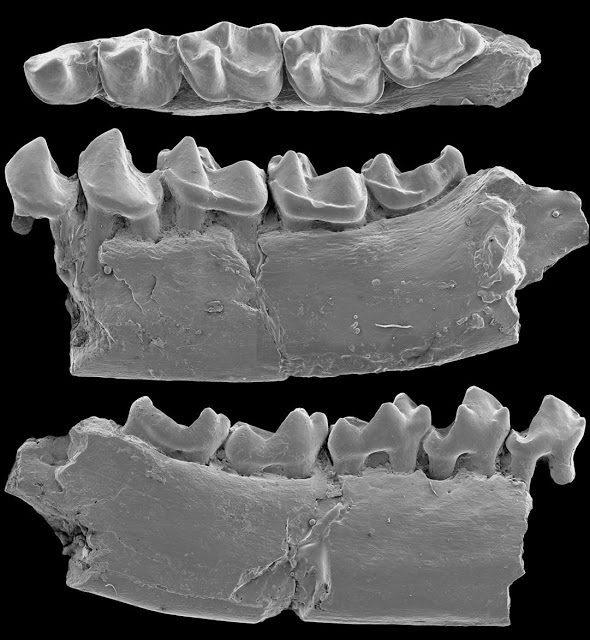The Strepsirhini (Lemurs, Lorises and Galagos) are often considered
to be ‘Lower Primates’, surviving representatives of a primitive stock from
which the ‘Higher’ Anthropoid Primates (Monkeys and Apes) arose. However they
are just as specialized in their way as the Anthropoids, and have a set of
adaptations not present in the other group, most notably a specialized
‘tooth-comb’ (specialized set of front teeth used in grooming). Estimates of
the age of the group vary, with molecular dating methods suggesting that the
most recent common ancestor of all living Strepsirhini lived some time in the
Late Cretaceous, while the earliest known fossils of the group date from the
Early Eocene, suggesting that either the group has a long ‘fossil gap’ (period
when the animals were present but left no fossils) or the ‘molecular clock’
dating method is inaccurate for Strepsihines.
In a paper published in the journal PLoS One on 4 December 2013, a
team of French and Tunisian scientists led by Laurent Marivaux of the Laboratoirede Paléontologie at Université Montpellier redescribe Djebelemur martinezi, an Early Eocene Primate that has variously
been considered an Adapiforme (an extinct group of Lemur-like Primates lacking
a tooth-comb, which includes the ‘Lemurs’ of Europe and North America), or an
early Anthropoid.
Djebelemur martinezi was originally described from a left dentary (jawbone) with two
preserved molars, from the Natural Park of Djebel Chambi in Tunisia, estimated
to be about 50 million years old. Since this time a number of other specimens
attributable to the species have become available, including a facial fragment
with a partial maxila (upper jaw) and numerous isolated teeth.
Lower jaw of Djebelemur martinezi
from the Djebel Chambi locality.(A) Fragments of right mandible, whichconsists
of three isolated pieces found together and reassembled here: the anterior part
of the dentary bears the p3 and m1, and alveoli for p4, p2and c, while the
posterior part preserves m3 and a portion of the ascending ramus; m2 was found
isolated but in the same small calcareous blocktreated by acid processing; (B)
photograph of the proximal part of the right mandible (for p4 and p3, note that
their mesialalveolus is slightly offset buccallywith respect to their distal
alveolus; the single alveolus for p2 is mesiodistally compressed and oblique,
while the alveolus for the canine, althoughonly partially preserved, appears
slightly larger, suboval, and more lingually positioned with respect to the
main axis of the toothrow). (C–G) noncompositelower toothrow with the mandible,
canine (reversed), p2 (reversed), and p4, in occlusal (C), lingual(D), frontal
(F), and distal (G) views; (H) left p2 in (from left to right) occlusal,
buccal, lingual, distal, and mesial views (not reversed); (I) left canine in
(from left to right) occlusal, buccal, lingual, distal, and mesial views (not
reversed). The 3D representations have been obtained by X-ray mCT surface
reconstruction. The crown and roots of teeth of the mandible have beenvirtually
delimited by manual segmentation. Marivaux et
al. (2014).
Marivaux et al. conclude
from this material that Djebelemur martinezi
had a primitive tooth-comb apparatus, and that it should therefore be
considered an early member of the Strepsihine lineage, though an analysis of
its phylogeny suggests that it branched off before the most recent common
ancestor of all modern members of the group. This in turn suggests that the
Strepsihines are younger than previously thought, probably originating in the
early Eocene. If this is the case, then the Strepsihines are considerably
younger as a group than the Adapiformes of Europe, and the may have arisen from
a small Adapiforme population that reached Africa from Europe, rather than both
groups arising from an more ancient African ancestor – which has implications
for the origins of Primates as a whole.
Facial fragment of Djebelemur martinezi
from the Djebel Chambi locality.(A–E) Left maxilla preserving P3-M3 andalveoli
for P2 and C1, in frontal (A), coronal section (cs) through M1 (B), palatal
(C), dorsal (D), and lateral (E) views; (F) left P4 in occlusalview. The 3D
representations have been obtained by X-ray mCT surface reconstruction. On the
maxilla, the crown androots of teeth have been virtually delimited by manual
segmentation. Abbreviations: IOF, infraorbital foramen; of, orbital floor; hp,
hard palate; pzm,processuszygomaticus maxillae; ra, root apex; jms,
jugo-maxillary suture. Marivaux et al. (2014).
Marivaux et al. also tried
to reconstruct the diet of Djebelemur martinezi,
based upon analysis of tooth wear and the potential shearing force that could
be applied by its jaws. Based upon this they conclude that it was probably an
insectivore. The shearing force it could apply would be far in excess of that
expected for a frugivore (fruit eater) of similar size, falling comfortably
within the range for leaf-eaters and a little on the low side for an insect
eater; however leaves require an extended digestive tract to process, and at an
estimated 80g Djebelemur martinezi is
highly unlikely to have been able to do this. The dental wear seen is also more
consistent with insectivory than any other diet.
See also…
Bushbabies (Galagidae) are African nocturnal Primates related to Lorises
(Lorisidae). Like the Lorises they are solitary nocturnal foragers
living in the tree canopy, but while Lorises are slow, deliberate
animals, the Bushbabies often move rapidly through the forest, and are
capable of leaping from tree-to-tree like Monkeys...
The Omomyids were a group of Palaeocene-Oligocene Primates similar, and
probably related to, the modern Tarsiers. They had large, forward
facing, eyes and grasping hands and feet with nails instead of claws.
Their teeth sugest that they had a diet of fruit and insects, and their
skeltel morphology that they lived in trees and that most species were
nocturnal. They appeared in the fossill...
Mouse lemurs are the smallest primates. They are nocturnal animals that
resemble Tarsiers or Bush Babies, but are true lemurs, all 27 known
species belonging to a single genus Microcebus. Like all modern lemurs they are found only in Madagascar (fossil lemurs are known from Africa, Asia and Europe).
Follow Sciency Thoughts on Facebook.





